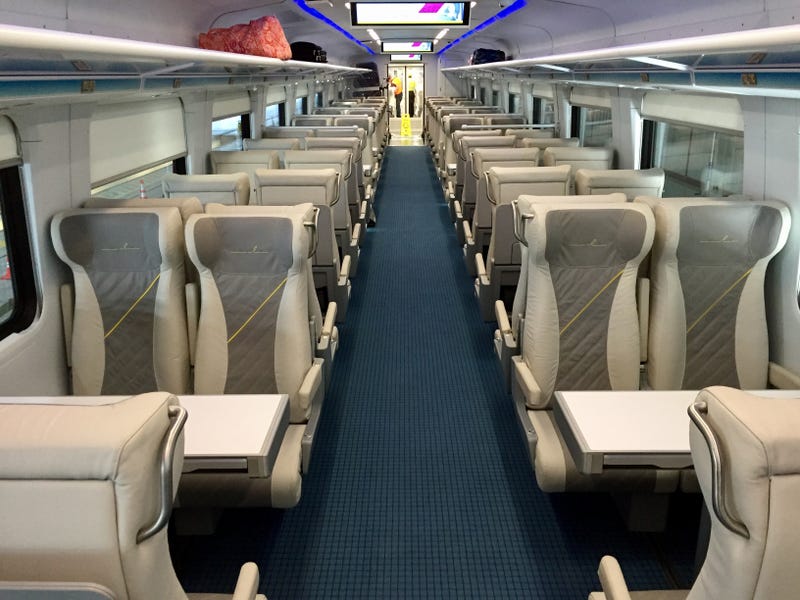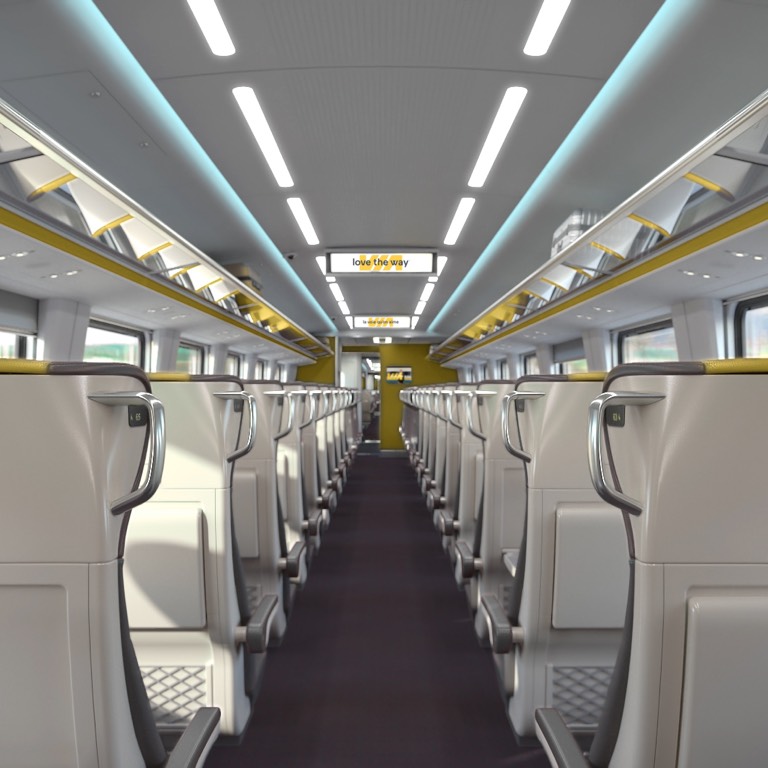You are using an out of date browser. It may not display this or other websites correctly.
You should upgrade or use an alternative browser.
You should upgrade or use an alternative browser.
- Thread starter ehlow
- Start date
roger1818
Senior Member
^^^Does anyone else find it odd that Transport Action Canada seems to be completely oblivious to the fact that Brightline have been using Siemens Venture trainsets for years?
Bordercollie
Senior Member
Brightline interior looks totally different. https://images.app.goo.gl/rbDM8HVznwB6rY1c7^^^Does anyone else find it odd that Transport Action Canada seems to be completely oblivious to the fact that Brightline have been using Siemens Venture trainsets for years?
cplchanb
Senior Member
i^^^Does anyone else find it odd that Transport Action Canada seems to be completely oblivious to the fact that Brightline have been using Siemens Venture trainsets for years?
the renders show dividers in the over head rack but not enclosed. I wonder if this will carry through to production... but still TC is stuck in the 60s/70s
tmlittle
Active Member
What's the issue with non-enclosed overhead racks for TC? Is it to mitigate luggage flying everywhere in a crash or something?i
the renders show dividers in the over head rack but not enclosed. I wonder if this will carry through to production... but still TC is stuck in the 60s/70s
smallspy
Senior Member
What's the issue with non-enclosed overhead racks for TC? Is it to mitigate luggage flying everywhere in a crash or something?
Non-enclosed luggage racks were implicated in injuries in several accidents over the years. So some time ago TC mandated that all luggage racks must have some sort of retention system to prevent those injuries from occurring in any future accidents.
Dan
Urban Sky
Senior Member
Transport Canada’s rail safety philosophy in a nutshell: crash mitigation instead of crash avoidance (ATP and strictly enforced minimum safety or track/equipment maintenance standards, anyone?)...Non-enclosed luggage racks were implicated in injuries in several accidents over the years. So some time ago TC mandated that all luggage racks must have some sort of retention system to prevent those injuries from occurring in any future accidents.
Dan
Last edited:
roger1818
Senior Member
Brightline interior looks totally different. https://images.app.goo.gl/rbDM8HVznwB6rY1c7
Totally different? To my eyes, most of the differences seem to be in upholstery.

Amtrak

Brightline

VIA Rail
This render makes the bike and luggage racks look quite different than either Brightline's or Amtrak's.

VIA Rail
Last edited:
roger1818
Senior Member
Transport Canada’s rail safety philosophy in a nutshell: crash mitigation instead of crash avoidance (ATP and strictly enforced minimum safety or track/equipment maintenance standards, anyone?)...
Optimally you want both. While it is better to avoid the crash in the first place, you can't avoid all crashes so it is good to mitigate the consequences of those.
Urban Sky
Senior Member
Europe does both. The main difference is that mainline derailments make national news whereas they are seen here in Canada with the same shoulder-shrugging as mass shootings south of the border:Optimally you want both. While it is better to avoid the crash in the first place, you can't avoid all crashes so it is good to mitigate the consequences of those.
Streety McCarface
Senior Member
Passenger derailments make national news here though too, it's freight derailments that result in no injuries that don't. Not good, but when the consequences are significant, the response generally is.Europe does both. The main difference is that mainline derailments make national news whereas they are seen here in Canada with the same shoulder-shrugging as mass shootings south of the border:
crs1026
Superstar
Am I reading those renders correctly? Looks to me like open luggage racks for Canada.
I know of no other jurisdiction where falling luggage is such a safety obsession. Sure, Canadian passengers have been injured by flying luggage in past incidents - but that’s hardly a world class view of safety. Somehow our safety investigators seem happy worrying about luggage while leaving bigger issues alone lest they offend the railways. Lots of bark over squirrels, not much bite over intruders.
- Paul
I know of no other jurisdiction where falling luggage is such a safety obsession. Sure, Canadian passengers have been injured by flying luggage in past incidents - but that’s hardly a world class view of safety. Somehow our safety investigators seem happy worrying about luggage while leaving bigger issues alone lest they offend the railways. Lots of bark over squirrels, not much bite over intruders.
- Paul
roger1818
Senior Member
Am I reading those renders correctly? Looks to me like open luggage racks for Canada.
I know of no other jurisdiction where falling luggage is such a safety obsession. Sure, Canadian passengers have been injured by flying luggage in past incidents - but that’s hardly a world class view of safety. Somehow our safety investigators seem happy worrying about luggage while leaving bigger issues alone lest they offend the railways. Lots of bark over squirrels, not much bite over intruders.
- Paul
I agree that it looks like that, but it could be an early rendering and the final product might be different. To be honest, I don't see what all the fuss is about. If having doors on the overhead compartments makes things safer, why not have them? Do people find it inconvenient to open the doors?
crs1026
Superstar
I agree that it looks like that, but it could be an early rendering and the final product might be different. To be honest, I don't see what all the fuss is about. If having doors on the overhead compartments makes things safer, why not have them? Do people find it inconvenient to open the doors?
For the passenger, the issue is a real inconvenience, yes. Mostly in the dilemma one faces on boarding.... is there enough luggage rack space in the rack at the door? If I take my luggage to my seat, will there be space for it overhead, or will I have to go hunting for same? Will my bag fit?
VIA's heritage/LRC fleet has pretty ample storage space at the end of the car. Looking for space is far less of a hassle than on an airplane, and on a train one can easily access one's bag during the trip. So it's perhaps as small thing and a bit hypothetical as yet. However, we don't know if the new cars will be as generous with luggage space.... especially with more space allocated to bicycle storage, etc.
My last trip to the UK involved a Virgin railcar which had absurdly little end of car luggage space, with the result that many passengers had bags in the aisle... hardly any safer. I would much prefer being able to spot the availability and dimensions of luggage space when I board.
For us armchair riders, it's perhaps a trigger - a constant reminder that we have this oddball regulatory environment with a very tunnel focus. Another example - on the long distance trains, all the small enclosed compartments are a safety concern as egress can be difficult in a derailment. VIA's solution is to ask someone in the car to be the volunteer safety monitor. You get a tag on the door to your bedroom identifying you as such, presumably so people will look to your leadership in a crisis. I have been put in this role, and I will confess I spent most of my waking hours in the dome car. So much for my contribution to my fellow passengers' safety.
Another example is all the cameras that sprang up at level crossings in the Fallowfield area after the Ottawa Transpo incident. Cameras don't enhance safety, but they make sure that no one will be in the same position of arguing over liability afterwards. The bureaucrats and lawyers have done a damn good job of closing the barn door on that one.
VIa is a sitting duck for regulatory nitpicking. Meanwhile, requirements for running and terminal inspections for freight trains have been loosened, trains run down hills with inoperative brakes, etc.
So while the luggage doors may be a small thing in the big picture, it does give us grounds to vent a little ;-)
- Paul
roger1818
Senior Member
For the passenger, the issue is a real inconvenience, yes. Mostly in the dilemma one faces on boarding.... is there enough luggage rack space in the rack at the door? If I take my luggage to my seat, will there be space for it overhead, or will I have to go hunting for same? Will my bag fit?
VIA's heritage/LRC fleet has pretty ample storage space at the end of the car. Looking for space is far less of a hassle than on an airplane, and on a train one can easily access one's bag during the trip. So it's perhaps as small thing and a bit hypothetical as yet. However, we don't know if the new cars will be as generous with luggage space.... especially with more space allocated to bicycle storage, etc.
My last trip to the UK involved a Virgin railcar which had absurdly little end of car luggage space, with the result that many passengers had bags in the aisle... hardly any safer. I would much prefer being able to spot the availability and dimensions of luggage space when I board.
For us armchair riders, it's perhaps a trigger - a constant reminder that we have this oddball regulatory environment with a very tunnel focus. Another example - on the long distance trains, all the small enclosed compartments are a safety concern as egress can be difficult in a derailment. VIA's solution is to ask someone in the car to be the volunteer safety monitor. You get a tag on the door to your bedroom identifying you as such, presumably so people will look to your leadership in a crisis. I have been put in this role, and I will confess I spent most of my waking hours in the dome car. So much for my contribution to my fellow passengers' safety.
Another example is all the cameras that sprang up at level crossings in the Fallowfield area after the Ottawa Transpo incident. Cameras don't enhance safety, but they make sure that no one will be in the same position of arguing over liability afterwards. The bureaucrats and lawyers have done a damn good job of closing the barn door on that one.
VIa is a sitting duck for regulatory nitpicking. Meanwhile, requirements for running and terminal inspections for freight trains have been loosened, trains run down hills with inoperative brakes, etc.
So while the luggage doors may be a small thing in the big picture, it does give us grounds to vent a little ;-)
- Paul
While I can see how having enough luggage space is a concern, I would hope that VIA has learnt from using the Renaissance cars (which don't have any luggage racks at the end of the car or overhead bins (just space for a small-medium sized bag under your seat and a cubby for a very small hand bag)) that having sufficient luggage space is important. As for the bike racks, if I had to guess, I would suspect that only one type of car will have them. One hint is the new cars are about the same size as the LRC cars yet have slightly fewer seats, so that should be a good sign. At this point though, things are as clear as mud and we are only speculating.
Regardless, large suitcases should not be placed in the overhead bins, whether they have doors or not. It always surprises me how many people have a poor understanding of the force of gravity. They expect their mammoth, 80 lb suitcase that is half sticking out of the rack to somehow levitate in midair, and not fall on the head of the person sitting below it mid voyage. From that perspective, doors help tell people what bags will fit and what bags won't.





